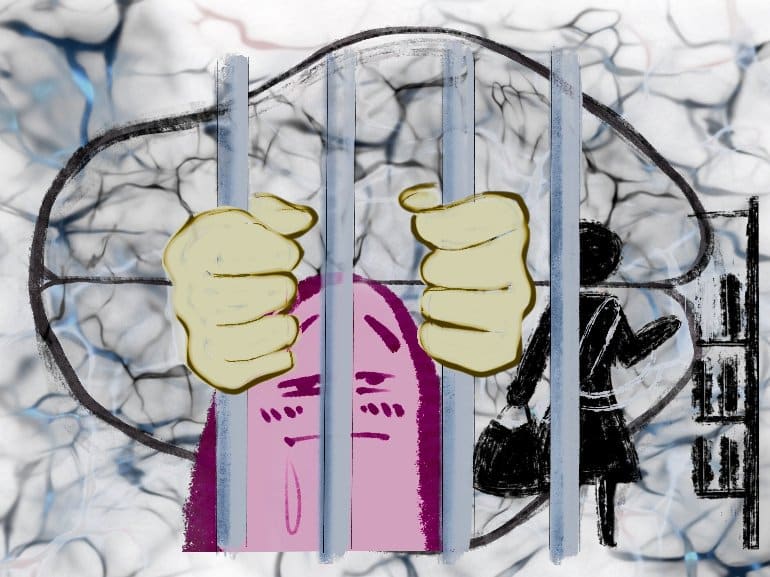Summary: People with kleptomania, or the overwhelming impulse to commit theft or shoplift, exhibit distinct patterns of gaze and brain activity when exposed to environmental cues associated with their compulsion.
Source: Kyoto University
A team of researchers at Kyoto University has recently found that patients with kleptomania exhibit distinct patterns of gazing and brain activity when shown images with environmental cues relevant to their symptoms. Such characteristics were not observed in healthy subjects.
“Studies such as ours could help deter impulsively committed crimes like shoplifting and contribute to realizing a better society,” says lead author Yukiori Goto.
Investigations of patients with alcohol addiction also revealed environmental cues leading to cravings, a phenomenon known as cue-induced craving.
“Although the sample size was small and still preliminary, our study reports for the first time that kleptomania may also involve the mechanisms that could be similar, if not identical, to those related to drug addiction,” notes Goto.
Other behavioral addictions observed in gambling, gaming, and Internet use share these mechanisms, clinically termed substance use disorder.
Kleptomania is characterized by pathological, compulsive, and repetitive stealing for the sake of the act itself and not motivated by any sense of material gain. Therapeutic treatments are becoming more important in preventing repeated convictions than conventional criminal penalties, which have been shown to be ineffective in curbing this maladaptive behavior.
While kleptomania meets the criteria of addiction and is classified as a “Disruptive, Impulse-Control, and Conduct Disorder” by the American Psychiatry Society, few studies of the condition have been published to date.

Goto’s research examined 11 patients with behavioral addiction and 27 healthy adult subjects. Each was shown still and video images, some containing symptom-relevant environmental cues—such as shops and their merchandise—with others depicting irrelevant ones such as natural scenery.
Using eye-tracking technology, all subjects’ gaze patterns were monitored while they viewed the test materials. Their brain activity was simultaneously measured with functional near-infrared spectroscopy, a non-invasive method that detects hemoglobin changes in the prefrontal cortex.
The team’s fNIRS recordings revealed compromised activity in the right prefrontal cortex of kleptomania patients during task performance. These results correlated with other behavioral addicts exhibiting an inability to estimate probability of risk and finding themselves in a reward system trap.
“Our study may lead to the development of therapeutic treatments targeting maladaptive learning, not only for drug addiction, but also impulse control disorders such as kleptomania,” reflects Goto.
About this addiction and neuroscience research news
Author: Press Office
Source: Kyoto University
Contact: Press Office – Kyoto University
Image: The image is credited to KyotoU/Jake Tobiyama
Original Research: Closed access.
“Distinct Situational Cue Processing in Individuals with Kleptomania: A Preliminary Study” by Yui Asaoka et al. International Journal of Neuropsychopharmacology
Abstract
Distinct Situational Cue Processing in Individuals with Kleptomania: A Preliminary Study
Background
Impulse control disorder has been suggested to meet the criteria of addiction and is often considered a behavioral addiction; however, few studies have examined whether the disorder involves altered responses to situational cues that are associated with symptoms. In this study, we examined behavioral and neural responses to situational cues among individuals with an impulse control disorder, i.e., kleptomania.
Methods
Healthy adults and kleptomania patients whose symptoms were characterized by repetitive, uncontrolled shoplifting of sales goods in stores were recruited. Images with and without situational cues (e.g., a grocery store) were presented, and gazing patterns for the images were detected with the eye-tracker. Additionally, prefrontal cortical (PFC) responses were measured using functional near-infrared spectroscopy. PFC activities were further examined while subjects were watching video clips in virtual reality with and without situational cues.
Results
Among kleptomania patients, the gazing pattern for an image with situational cues was distinct from gazing patterns for other images; such differences were not observed in healthy subjects. Consistent with gazing patterns, PFC local network responses by hemoglobin changes to images and videos with situational cues were substantially different from other images and videos in kleptomania patients, whereas PFC responses were consistent across all image and video presentations in healthy subjects.
Conclusions
These results suggest that kleptomania patients may perceive situational cues associated with their problematic behaviors differently from healthy subjects.






